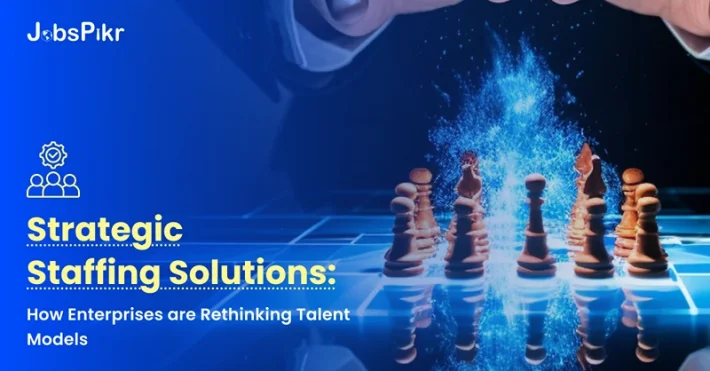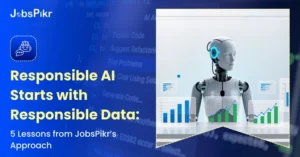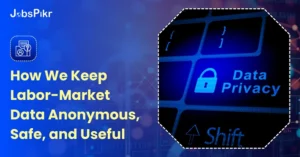Each company faces an ever-dynamic challenge while acquiring and managing new talents in the organization. As the market is highly volatile and technologies are constantly shifting, the need for addressing innovative changes is crucial and so is addressing the expectations of evolving employees.
Strategic staffing solutions, or staff pyramid models, help companies focus on dynamic hiring, allowing them to remain competitive. From outsourcing and contingent hiring to project-based roles, these models are flexible and scalable, allowing businesses to integrate modern technologies and immediate staffing needs.
Strategic staffing alone would hamper smooth operations, however integrating advanced technologies can be a game changer to the workforce strategy. Having access to real-time demands and trends, data-driven decisions can be streamlined from the very first day.

The Evolution of Staffing Models
Developments in technology dictate the future, hence revisions need to be made depending on real-time statistics. By integrating advanced staffing and sourcing insights, companies can draft smarter frameworks to navigate hiring challenges during core operational hours. …however, organizations initially struggle with flexibility when integrating novel changes. Companies start investing heavily into the long-term development of employees which culminates in loyalty.
The rise of the gig economy, along with hybrid work models, has, and is still, drastically reshaping the modern workforce. A Gartner report states that by 2027, 25% of the employees in big corporations will be nontraditional workers, ranging from freelancers to contractors and gig employees. This change also strongly necessitates more agile and inclusive staffing strategies.
Businesses are exploring new staffing approaches, including:
- Contingent Staffing: Engaging temporary workers or freelancers to manage seasonal demand, specialized tasks, or unexpected workloads.
- Project-Based Hiring: Bringing in professionals with niche expertise to contribute to specific projects without committing to long-term employment.
- Hybrid Workforce Models: Integrating full-time employees with part-time or on-demand workers to maintain flexibility while ensuring operational continuity.
- Managed Services and Outsourcing: Delegating functions like IT support, customer service, or payroll management to external vendors for cost efficiency and scalability.
Over reliance on these approaches will empower businesses with the flexibility to swiftly modify operations, exercise greater control over labor costs, and eliminate geographical restrictions to tap into talent from around the world.
The Role of Data in Strategic Staffing
Incorporating flexibility alone is not enough when it comes to strategic staffing; it also requires foresight and meticulous data-driven planning. Utilizing real-time market data and talent analytics will enhance business staffing strategies, ensuring both current needs and future demands are met.
Through data, organizations can do the following:
- Forecast Talent Demand: Predict workforce requirements based on upcoming projects, seasonal patterns, and macroeconomic indicators. This helps prevent both overstaffing and talent shortages.
- Analyze Workforce Utilization: Determine how effectively existing staff are being deployed and identify underutilized resources that could be reassigned to higher-value work.
- Pinpoint Skills Gaps: Compare current workforce skills against emerging demands to inform upskilling programs or target specific roles in external hiring.
- Track Vendor and Contractor Performance: Evaluate the effectiveness and reliability of external staffing partners using KPIs such as cost per hire, time-to-productivity, and quality of deliverables.
- Assess Market Competitiveness: Benchmark compensation, hiring velocity, and job descriptions against market data to ensure your roles remain attractive to top talent.
Using a platform like JobsPikr allows HR teams to tap into live job market trends, competitor hiring activity, and regional talent availability to build more responsive staffing strategies. For instance, a study by ShiftMed highlights the importance of data-driven staffing decisions in healthcare, emphasizing how analytics can enhance operational efficiency and improve service quality.
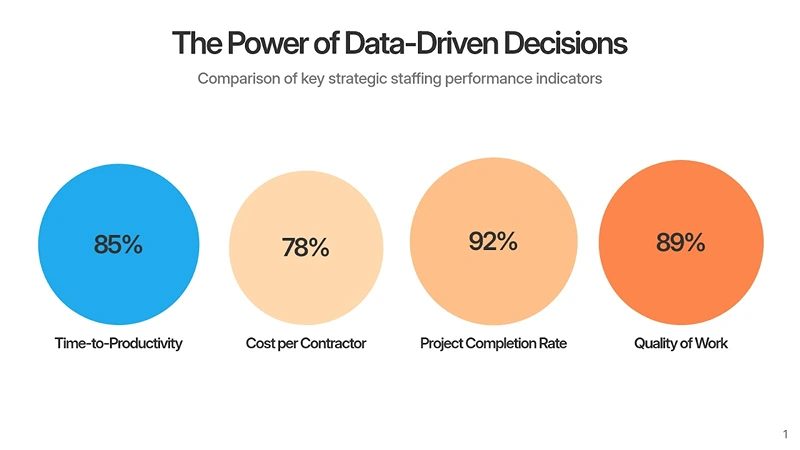
Benefits of Strategic Staffing Solutions
Strategic staffing frameworks offer notable advantages to businesses aiming to remain nimble and prepared for the future:
Increased Agility and Flexibility
Flexible staffing enables organizations to adjust workforce levels quickly in response to demand fluctuations. This is particularly valuable during economic uncertainty, project launches, or periods of rapid growth.
Cost Efficiency
With strategic staffing, enterprises can reduce costs related to benefits, training, and overhead by relying more on on-demand talent. Hiring on a project basis also reduces the financial risks associated with long-term employment.
Wider Talent Pool
Broadening your staffing approach gives access to a wider talent ecosystem, including remote workers, independent consultants, and part-time professionals. This helps overcome geographic hiring limitations.
Innovation Through Diversity
Temporary and contract workers often bring fresh perspectives and new skills. Mixing internal and external expertise encourages innovation and accelerates problem-solving.
Speed to Market
Strategic staffing allows teams to execute faster by bringing in pre-qualified experts for specific needs. This reduces ramp-up time and boosts productivity from day one.
Risk Management
Strategic staffing helps distribute risk by reducing reliance on a single workforce model. In times of market disruption, having diversified staffing options allows business continuity. A report from Deloitte underscores the importance of rethinking talent approaches, especially in tight job markets, to maintain a competitive edge.
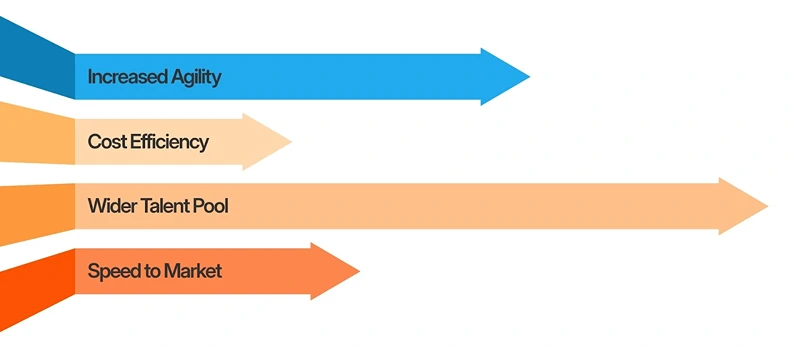
Best Practices for Implementing Strategic Staffing
Moving towards strategic staffing requires a proactive and organized process, which is noteworthy. Here’s how enterprises can ensure successful implementation:
1. Conduct a Workforce Needs Assessment
Evaluate current talent structures, workload projections, and anticipated skills gaps. Identify functions that can be delivered through flexible staffing models without sacrificing quality or compliance.
2. Define Staffing Policies and Guardrails
Establish clear criteria for when and how contingent or project-based workers are used. Set expectations around work scopes, deliverables, and compliance requirements to ensure consistency.
3. Build a Trusted Vendor Ecosystem
Establish partnerships with reliable staffing agencies, freelance platforms, and managed service providers. Vet them thoroughly and regularly review performance using defined metrics.
4. Use Technology for Workforce Planning
Adopt workforce intelligence tools like JobsPikr to monitor labor market trends, identify talent-rich regions, and map competitor hiring patterns. Use this data to inform where, when, and how you hire.
5. Upskill Internal Teams for Hybrid Management
Train managers on how to integrate and collaborate effectively with freelance, part-time, or remote team members. This helps ensure consistent team culture and productivity.
6. Monitor KPIs and Adjust Strategies
Track metrics such as time-to-hire, cost per contractor, project completion rates, and quality of work. Use these insights to refine your staffing strategy over time.
Strategic staffing isn’t just about filling gaps—it’s about building workforce resilience and future-proofing your talent operations.
The Future of Staffing: Embracing Change
All businesses need to adapt their staffing approaches in response to an ever-changing global business environment. Companies that capitalize on strategically staffing their business stand a greater chance to thrive, showing increased innovation and change adaptability. An emphasis on agility, data-informed actions and a broader talent spectrum enables a company to handle the complications of the current workforce confidently.
Utilizing tools such as JobsPikr can improve these strategies as it offers real-time up-to-the-minute data for informed staffing decisions. Whether you are assessing vendor performance, engaging in project-specific fillable positions, or tracking skill prevalence by geography, having groundbreaking insights at your fingertips is crucial.Sign up on JobsPikr to start building staffing strategies grounded in real-time data and future-focused planning—because staying ahead starts with smarter workforce intelligence.
